
Welcome to the WDAS monthly newsletter for March 2019: a digest of the month's latest contributions to our website. Below you'll find Society News covering the Dark Matter Exhibition, a rare visit to the Bruce Observatory, and Sky Notes for the coming month.
Society News
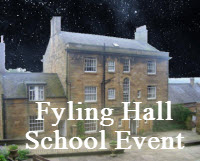 On March 1st we will be hosting an event at Fylinghall School, which is also being co-promoted by Baytown Coffee.
On March 1st we will be hosting an event at Fylinghall School, which is also being co-promoted by Baytown Coffee.
It’s 3 years since we last visited the School for a star night event, and it will be nice to renew ties. If conditions are satisfactory (not chucking it down, blowing a Hooley, or knee deep in snow- none of which look likely) the boarding students will be flogged enlisted to help out with a scaled solar system demonstration before observing is commenced, or the implementation of plan B (indoor presentation).
The location will be the front lawn of the School (facing the sea) starting around 19:20h. We shall therefore need to be present on site by 19:00h. Assistance with equipment transportation would be very welcome. We'll depart from Mark’s at 18:30h.
The event has been publicised in the Whitby Gazette, but further details can be found by contacting Angelique on marketing![]() fylinghall.org.
fylinghall.org.
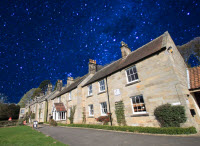 On Saturday March 2nd we will be in action again at the Danby Moors Centre for their Dark Sky half term event.
On Saturday March 2nd we will be in action again at the Danby Moors Centre for their Dark Sky half term event.
This is their ‘flagship event’, and if skies are clear we shall definitely require assistance from members regarding scopes/transport, similar to the event held last October.
Hopefully skies will be clear this time round, if so, we shall be observing some of the jewels of the winter sky. The event runs from 19:00h-21:00hpm, so we shall have to set off shortly after 6pm to allow time to set up equipment etc if conditions look promising.
These National Park events for the North Yorkshire area have been highlighted in the Astronomy Now Magazine extensively across the area, so it is likely to be sold out (If previous star party nights are anything to go by) with around 60-80 people present.
Although still a week away as this is written, the weather does look quite promising, so i hope it will be a good evening. We shall be meeting at Mark’s around for 17:55h.
The exhibition has now opened and is most definitely worth a visit. Sponsored by the Royal Society, the exhibition showcases the area’s connections investigating the cosmos, from Captain Cook’s 1768 voyage observing the transit of Venus to the search for Dark Matter at Boulby Underground Laboratory. The exhibition runs until early July.
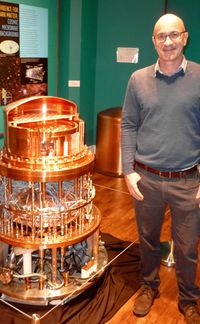 Mark and Phil were fortunate enough to be present at the opening night. After drinks and delicious nibbles, the exhibition was formally opened, before we were invited to preview the exhibition itself. This is first class, very professional looking, with some fantastic exhibits and plenty of explanatory text and picture boards to peruse at leisure.
Mark and Phil were fortunate enough to be present at the opening night. After drinks and delicious nibbles, the exhibition was formally opened, before we were invited to preview the exhibition itself. This is first class, very professional looking, with some fantastic exhibits and plenty of explanatory text and picture boards to peruse at leisure.
The undoubted star of the show (apart from the societies corner ) is the Zeplin 3 detector, which has been donated by the Dark Matter research team, and has been cut away to reveal the inner workings – all polished copper, photo couplers, and leads – it looks more like a work of art than a device to detect WIMPS from outer space! And to think the whole lot was entombed in lead.
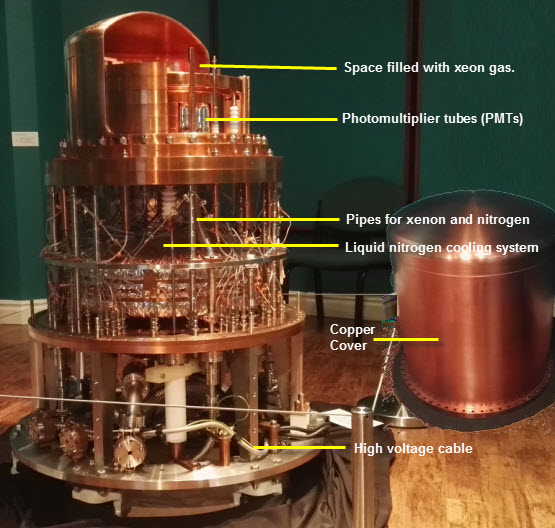
The Zeplin III's job is to detect the weak nuclear force by converting it into electrical charge
and light.When a WIMP collides with a nucleus of xenon it exerts a weak nuclear force. This collision
produces a tiny elecdtrical charge (in a process called ionisation) and a photon (in a process called
scintillation). Other particles also cause these effects, but measuring the ratio between the ionisation
and scintillation gives a definititve indication of whether a WIMP (hence dark matter) has been found.
A lecture was then given in the Normanby room by Professor Henrique Araujo of Imperial College London. “The Search for Dark Matter”, highlighted the internationally important work carried out at Boulby Underground Laboratory, and how the expertise of the various researchers is helping other Dark Matter labs in their research.
Although for the time being, the hunt for WIMPS has now ceased at the Boulby facility, it is nevertheless continuing on at pace in numerous other sites across the globe, in particular at the Sanford Underground Research Facility (SURF) in the Homestake mine – Lead, South Dakota.
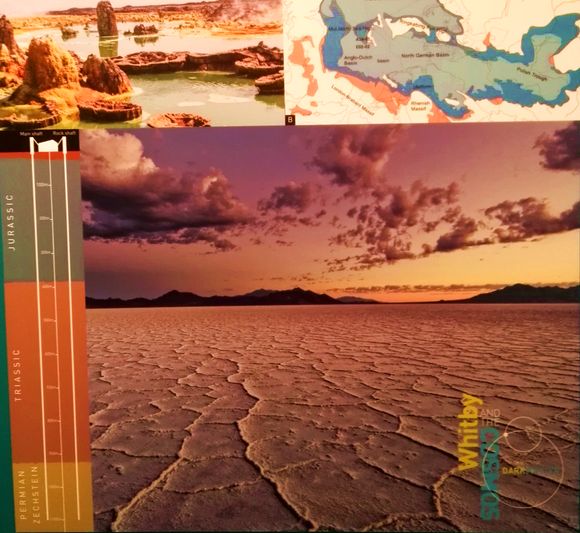

Top: 256-300m years ago, Boulby was close to the Zechstein Sea in the super-continent of Pangea.
N. Europe lay in the tropical belt and the sea went through repeated cycles of evaporation and flooding.
Bottom: Rocks mined at Boulby: Sylvinite/Potash (left); Halite/Rock salt (middle); Polyhalite (right).
Like Boulby, this is around a mile underground. Unlike Boulby, which after the 2009 economic crash, couldn’t secure funding for a Zeplin upgrade ie more liquid xenon (research always the first to suffer in the UK) Sanford seems to have had no such problem and have married together ideas and concepts used in Zeplin with their own.
Work on building the equipment for an experiment called LUX–ZEPLIN has already commenced, which according to Prof Araujo will try to detect particles of dark matter as soon as 2020. It seems the key in detecting WIMPS is much greater sensitivity of equipment, which also means larger quantities of liquid xenon, and that means deeper pockets.
So, the hunt goes on, but hopefully in the next 3 or 4 years the detection of WIMPS will verify that dark matter is real, and that the greater than expected rotational speed of spiral galaxies is not the work of some ‘unseen hand’.
Mark had a bit of a surprise at the event, more precisely, with someone who was present. More of which at our March meeting, suffice to say it’s a strange, small, world sometimes.
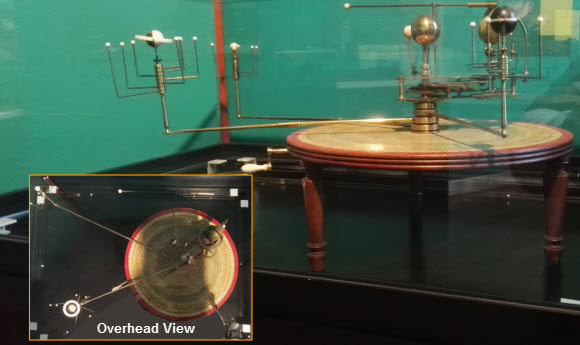
An Orrery (made between 1814 and 1839) at the Dark Matter Exhibition: a working model of
the Solar System showing the relative movements of the sun, planets and their moons.
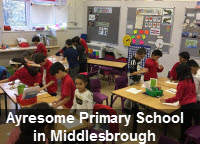 Our association with Ayresome Primary School & Lego Innovation Studio will be continued again this year after been contacted by Elizabeth Labelle; assistant Head Teacher (phase3).
Our association with Ayresome Primary School & Lego Innovation Studio will be continued again this year after been contacted by Elizabeth Labelle; assistant Head Teacher (phase3).
This year’s group of pupils (around 30 or so) will be stopping at the Whitby Youth Hostel from April 8th - 12th and we shall be hosting a star party event for them on either the 9th, 10th, or 11th, whichever evening according to the forecast looks best. We have hosted these events for the last three years, and Libby always says how much the pupils get from the event.
Start time will be around 20:15h on the Abbey Visitor Centre grass forecourt area.
After receiving a most intriguing email from Mr Jim Storey, concerning a Mr Norman Wright, who was keen on visiting the Bruce Observatory, it was arranged to meet up with Jim and Norman at the observatory on February 17th.
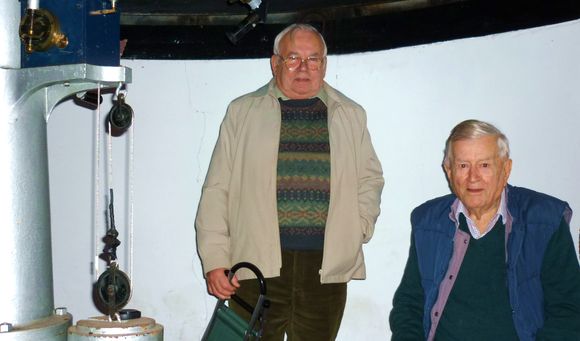
Jim Storey (left) and Norman Wright (right) at the Bruce Observatory
Fortunately it was a fine evening, with a gibbous moon visible. Norman, who is 91 and is a Bruce family relative, had never been in the Observatory before, or knew too much about it. He is keen however to see that it does not fall into disrepair (more on this next month).
Although unable to look through the telescope satisfactory, Norman nevertheless appeared to thoroughly enjoy his visit, and hear an account of its history (at least the parts we know of) as well as the restorative work and subsequent use by society members.
A brief word regarding society monthly meetings. It is very encouraging to see quite a few new (and some familiar) faces at the meetings (17 last month) If any members have something to share or are willing to give a presentation or talk related to astronomy, please contact Mark.
Events
 Observe the night sky with us at the Bruce Observatory, Whitby School
Observe the night sky with us at the Bruce Observatory, Whitby School
Observing Nights are held weather permitting: check for a relatively clear sky before leaving home. If in doubt, Mark can be reached on 07886069339
Please note the college drive gate is now operated via a electronic key code - so anyone wishing to attend must be at the car park at the top of the drive by 19:00hrs - unless an arrival time has been arranged with Mark/Keith.
 Whitby School - Room H1.
Whitby School - Room H1.
In Members' monthly meetings we usually take a tour of the night sky for the coming month using the Planetarium program. Have talks and presentations on various topics of astronomy/space etc, and discuss future events etc. New members welcome.
 Observe the night sky with us at the Bruce Observatory, Whitby School
Observe the night sky with us at the Bruce Observatory, Whitby School
Observing Nights are held weather permitting: check for a relatively clear sky before leaving home. If in doubt, Mark can be reached on 07886069339
Please note the college drive gate is now operated via a electronic key code - so anyone wishing to attend must be at the car park at the top of the drive by 19:00hrs - unless an arrival time has been arranged with Mark/Keith.
 Observe the night sky with us at the Bruce Observatory, Whitby School
Observe the night sky with us at the Bruce Observatory, Whitby School
Observing Nights are held weather permitting: check for a relatively clear sky before leaving home. If in doubt, Mark can be reached on 07886069339
Please note the college drive gate is now operated via a electronic key code - so anyone wishing to attend must be at the car park at the top of the drive by 19:00hrs - unless an arrival time has been arranged with Mark/Keith.

